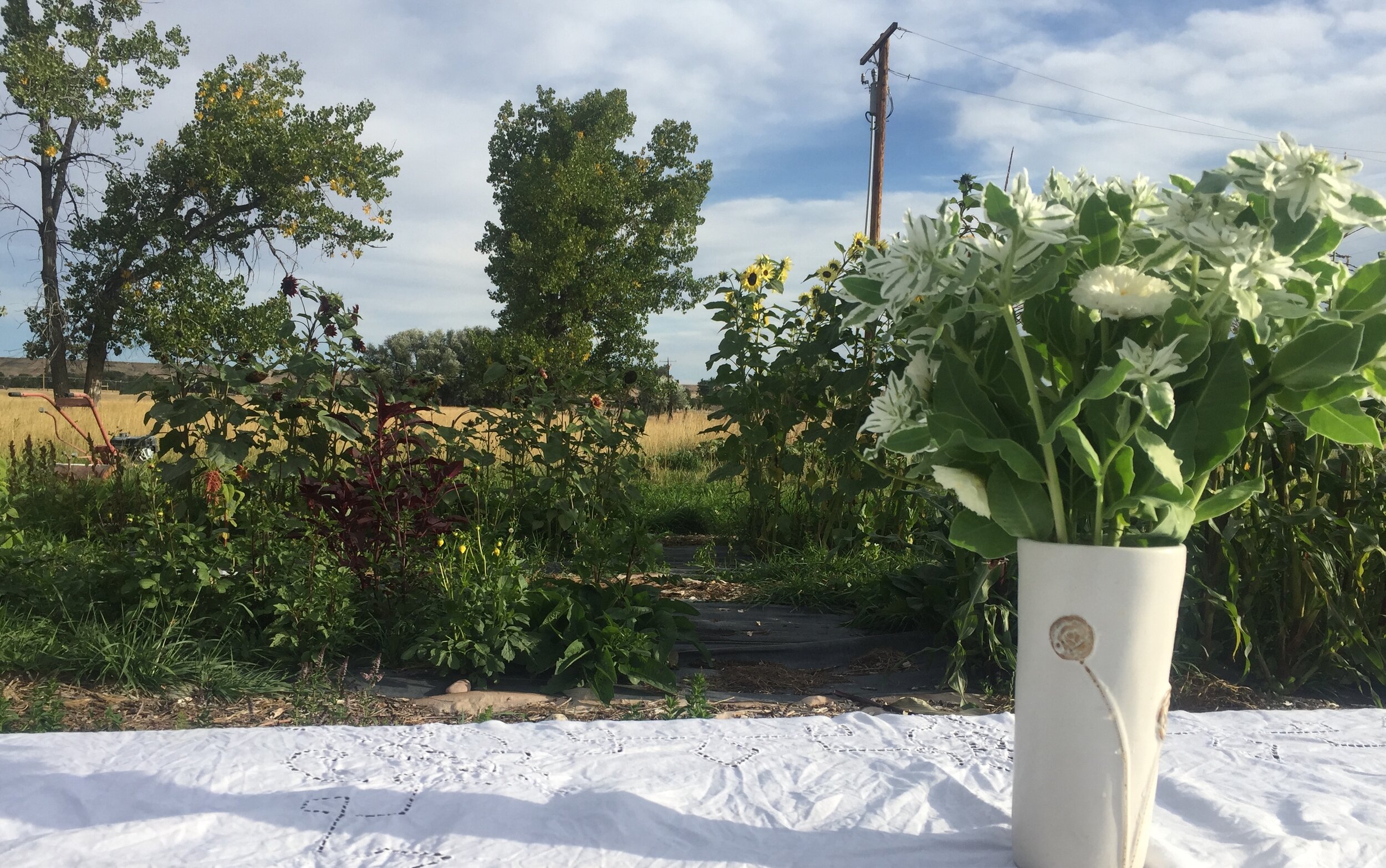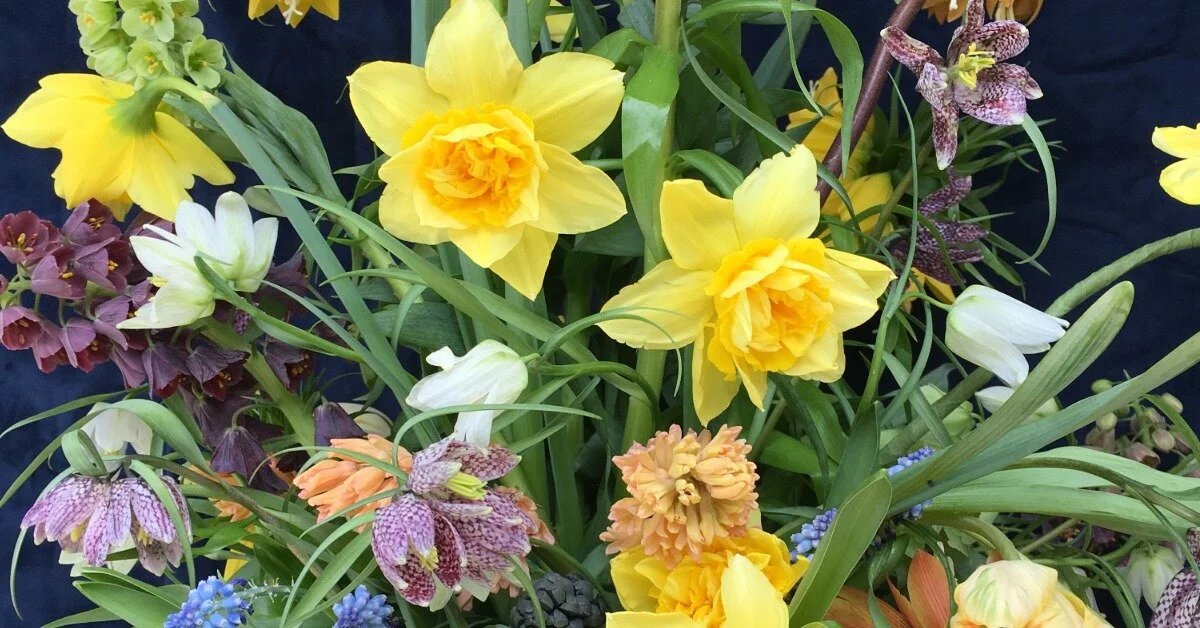How to Transform Your Flower Farm into a Garden
If you’ve done any research regarding growing cut flowers, there’s a good chance you’ve run into the advice that you have to toss out your impractical gardening notions; rows and rows of carefully sorted sowings and transplants are the only way to go. While this is a very practical way of doing things (and every flower farm in bloom is a sight to behold), I have good news for those who balk at the idea of trading the flowing beauty of a garden for straight rows and sorted colors and varieties. It is possible to maintain an organic feel and grow in large quantities. I’ll walk you through some of the pros and cons, as well as share some ideas for landscaping your space.
We’ll cover a lot of information in this article, so here is a quick list of the high points to get you started.
How to Transform Your Farm into a Garden:
Let yourself dream. Hire a landscape architect if you can.
Research, research, research. Be realistic about the pros and cons and what works best for you, your market, and your growing zone.
Put your plan on paper. Take it step by step as your time and budget allows.
Develop your garden in stages. Make your plants work for you—think through planting foliage and shrubs in ways that can set backdrops and hedges for your garden.
Enjoy the process. Your flower farm garden won’t instantly be elegant, but visitors expect a farm to look like, well, a farm!
Okay, now let’s dive into the pros and cons of developing your flower farm into the garden of your dreams!
Disadvantages
Of course there are drawbacks, so let’s get those out of the way so we can talk about the happy stuff! First of all, there are good reasons that people choose to organize their flower farm in a traditional manner. It’s easy to find a flower that is growing with 40 others just like it. It is also easy to access that flower with a nice straight walking row right next to it. If you are a practical person, the only value this article has for you may be something like people-watching. But by all means, read on and enjoy our differences! The rest of you will have to consider how much functionality you’re willing to trade for romance.
For example, harvesting can be less streamlined. Instead of going to one section of the field, a given variety might be dotted along a couple of borders. Some forethought (keeping each variety to a given section, planting in patterns, keeping like colors away from each other to avoid confusion, etc.) can solve some of these problems. But remember, we’re choosing to add much beauty at some cost. This is one of the ways we pay for beauty: we walk around our lovely farms which are flowing with rainbows of color to get what we need for this week’s orders. There have been worse things.
As you’ll read farther on, many of these suggestions require some amount of commitment. The advantage with long, straight beds or wide rows is that you can change the size and/or location of your annuals every season or even with a succession sowing. Also, besides sun and soil, perennials normally don’t need a ton of forethought compared to the planning that goes into a large cutting garden.
In summary, here is a quick list of the cons of creating a garden out of your flower farm:
Reduced functionality
Harvesting can be less streamlined
Unable to easily change the size or location of growing beds and rows
Advantages
When faced with a hard day of work ahead of you, very few things are more motivating than walking into a dreamland to do that work. It’s a wonderful thing to sip your coffee (or turmeric tea if that’s your jam) and sigh in delight at the view you “have” to look at all day. There is a reason that it’s worthwhile to lose some amount of function. Great books, movies, music, and art have been teaching us this from the beginning of time: the fruit of beauty is invaluable.
Your location itself becomes a value-added product. Beautiful landscaping is begging to be enjoyed. You could keep it to yourself and some private parties, or you could add location services to your menu. From you-pick days and farm-to-table events to business events and weddings, there are many options to explore! Be sure to look into any insurance or legal protection you might need to invite people onto your farm.
Monoculture is hard on plants. When a variety of plants grow together, they compete and share pests less. For example, a lupine planted next to a heavy feeder such as a rosebush will bring up and deposit nitrogen. You can use nitrogen-fixing shrubs like false indigo or trees such as honey locust to feed a variety of ornamental plants for your cutting garden. The result is beautiful and more self-sustaining than monoculture. Even in rows, you can alternate nitrogen-fixing plants with others. For example, around my perennial beds, I have a border with alternating pairs of roses and peonies; each pair with lupine in between.
In summary, here is a quick list of the pros to creating a garden out of your flower farm:
The pure delight of working in a garden
Your property may be more desirable for private events (additional revenue!)
More self-sustainable than monoculture
Tips and Ideas
For so many reasons, start thinking long term. Perennials often bring in a higher price per stem, so regardless of your layout, you should be growing them. But if you’re going to do some creative landscaping, they can serve several functions. If you have the funds, invite a landscape architect into the process or attend a free class. Nurseries sometimes offer courses to educate their consumers and encourage business.
The first thing to do is let yourself dream. Make a list of purposes you hope your farm/garden will serve and then lay out your dream garden. Look at the English garden, the French potager, and the Japanese Zen garden for inspiration. You might include permanent pathways, a variety of bed shapes, or meeting areas. This could mean you leave grassy, mulched, or paved areas for tables, chairs or tents. Will you need electricity in certain areas? Vehicle access? Don’t be afraid to think really big! There is no shame in shifting your direction in future years, but without vision, you’ll never do it.
After you’ve gotten your big plan on paper, divide it up into manageable steps to be taken one year at a time. Obviously, some steps order themselves. For instance, the veranda will have to be finished before you can make beds and plant around the edges of it. But also consider what will have a good return for your investment. It’s rewarding to have something so beautiful pay for itself!
Try to invent as many ways possible for your plants to work for you. If you want to use ninebark for foliage, you could plant it as a backdrop behind raised beds of annuals or a plant an entire field with rows of alternating perennials as mentioned above. Consider sectioning off your annuals with perennials. You can use shrubs for hedges or tall flowering perennials as borders and plant annuals in all manner of patterns within them. This can also allow you to go in stages. You can spend your perennial budget for one year surrounding one area of annuals and move on to other sections in future years.
Don’t be afraid if it doesn’t look super elegant right away. Sometimes I feel embarrassed when customers visit my farm, thinking it’s not pristine enough. But one of my clients from a high-end wine store has asked to use us for farm-to-table events. People expect a farm to look like one, and they enjoy getting a glimpse of where the product originates. This connection is so vital to the success of local growers! Share your hard work with confidence.
The first flower farm I visited when I was planting my first seeds was nothing but a large back yard 2/3 full of flower beds. At the far end, they planted in giant blocks almost like a checkerboard with a greenhouse right in the middle. What made it so beautiful was the meandering strips of perennials on either side of the grassy area. So as you made your way across the lawn to get to the main beds, you found yourself hemmed in by echinacea, lavender, rudbeckia, and something new every few feet. While I encourage visionary planning, I also want you to remember that every small step toward a more aesthetically pleasing farm is worth enjoying and being proud of.
The final tip I have is a must, but I saved it for last because I like it the least: documentation. You must record EVERYTHING. And there’s a lot more to record if you have five colors of David Austin roses scattered amongst hundreds of other plants. But read that again, and just imagine it. So. Gorgeous. Simply imagining walking through it takes away some of that tension you just felt at writing down every single plant, not to mention harvesting them. But unless you have oodles of cash begging to be spent all at once, you’ll probably work in stages, which makes it easier to remember where everything is when it comes time to harvest. And when brain fog hits and you forget where the right color dahlias are, it will be neatly mapped out in your office. I still plant my annuals according to variety in wide rows, so those are always easy to find and harvest. For me, it’s not a big deal to walk by several perennial borders and grab all of the particular blooms I’ll be using. Again, you have to decide where you fall on the spectrum between romance and practicality, and then stick with what works for you.
In Closing
Growers, I would argue that we produce one of the most uplifting, personal, and touching products a farmer can grow. So why not allow the ground we grow them on to do the same for us and those who visit? Ancient wisdom has asked us, what is left for us except to enjoy the fruits of our labor? If cut flowers become nothing more than work, what’s the point? Everyone who receives them is delighted by them; you should be too! Although it will look different for every grower, I encourage you to set yourself up in a way that allows your flowers to be a blessing to you in the process.









